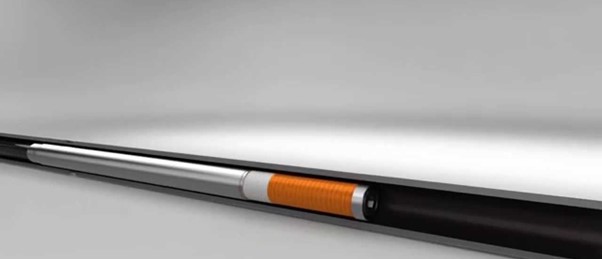
Remote Field Eddy Current Testing (RFET) is an electromagnetic non-destructive testing (NDT) technique primarily used to inspect ferromagnetic tubes and pipes. While conventional eddy current testing is well-suited for non-ferromagnetic materials, RFET is designed to overcome the limitations of ECT when inspecting ferromagnetic materials like steel.
How does RFET work?
RFET utilizes a probe with two coils: an exciter coil and a receiver coil. The exciter coil generates an alternating magnetic field, and the receiver coil detects changes in that field after it has passed through the tube wall.
- Exciter Coil: An alternating current is passed through the exciter coil, creating a magnetic field that penetrates the tube wall.
- Magnetic Field Path: The magnetic field travels through the tube wall, propagates along the tube, and then passes back through the tube wall to reach the receiver coil. This “through-transmission” is a key characteristic of RFET.
- Receiver Coil: The receiver coil, located a distance away from the exciter coil, measures the changes in the magnetic field.
- Detection of Discontinuities: Defects or changes in the tube wall, such as corrosion or wall thinning, alter the magnetic field path and are detected as variations in the receiver coil’s signal.
Key differences between ECT and RFET
- Material: ECT is primarily used for non-ferromagnetic materials, while RFET is used for ferromagnetic materials.
- Coil Spacing: RFET uses a larger distance between the exciter and receiver coils compared to conventional ECT.
- Depth of Penetration: RFET can achieve a more uniform sensitivity to defects on both the inner and outer surfaces of the tube wall.
- Magnetic Field Path: ECT relies on measuring changes in the magnetic field close to the tube surface, while RFET measures the field that has passed through the tube wall.
Applications of RFET
RFET is commonly used in industries that rely on the integrity of ferromagnetic tubes and pipes:
- Oil and gas: Inspection of pipelines and casings.
- Power generation: Inspection of boiler tubes and heat exchangers.
- Petrochemical: Inspection of piping systems.
Advantages of RFET
- Relatively equal sensitivity to defects on both the inner and outer surfaces of the tube wall.
- Suitable for ferromagnetic materials.
- Good for detecting general wall thinning and corrosion.
- Less sensitive to probe wobble than conventional ECT.
Limitations of RFET
- Less sensitive to small, localized defects such as pits compared to conventional ECT.
- Lower inspection speed than some other methods.
- сигнал interpretation can be complex.
- Affected by magnetic permeability variations in the material.
